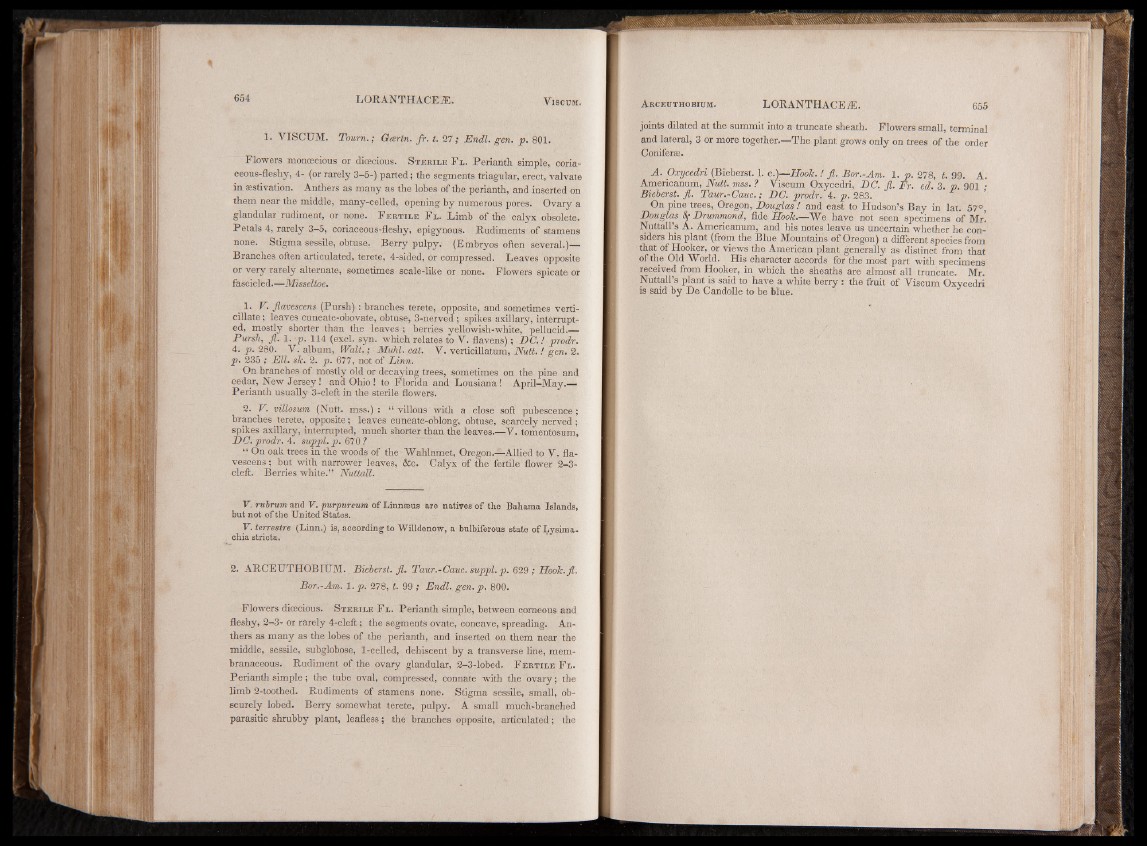
1. YISCUM. Tourn.; Gcertn. fr. t. 27; Endl. gen. p. 801.
Flowers monoecious or dioecious. S teril e F l . Perianth simple, coriaceous
fleshy, 4- (or rarely 3-5-) parted; the segments triagular, erect, valvate
in aestivation. Anthers as many as the lobes of the perianth, and inserted on
them near the middle, many-celled, opening by numerous pores. Ovary a
glandular rudiment, or none. F er til e F l . Limb of the calyx obsolete.
Petals 4, rarely 3-5, coriaceous-fleshy, epigynous. Rudiments of stamens
none. Stigma sessile, obtuse. Berry pulpy. (Embryos often several.)—
Branches often articulated, terete, 4-sided, or compressed. Leaves opposite
or very rarely alternate, sometimes scale-like or none. Flowers spicate or
fascicled.—Misseltoe.
j 1- y . flavescens (Pursh): branches terete, opposite, and sometimes verti-
cillate; leaves cuneate-obovate, obtuse, 3-nerved ; spikes axillary, interrupted,
mostly shorter than the leaves ; berries yellowish-white, pellucid.—
Pursh, fl. 1. p. 114 (excl. syn. which relates to Y. flavens); DC.! prodr.
4. p. 280. V. album, Walt.; Muhl. cat. V. verticillatum, Nutt. ! gen. 2.
p. 235 ; Ell. sk. 2. p. 677, not of Linn.
On branches of mostly old or decaying trees, sometimes on the pine and
cedar, New Jersey! and Ohio! to Florida and Lousiana! April-May.—
Perianth usually 3-cleft in the sterile flowers.
2. V. villosum (Nutt, mss.) : “ villous with a close soft pubescence;
branches terete, opposite; leaves cuneate-oblong, obtuse, scarcely nerved ;
spikes axillary, interrupted, mueh shorter than the leaves.—V. tomentosum,
DC. prodr. 4. suppl. p. 670?
“ On oak trees in the woods of the Wahlamet, Oregon.—Allied to Y. flavescens
; but with narrower leaves, &c. Calyx of the fertile' flower 2-3-
cleft. Berries white.” Nuttall.
V. rubrum and V. purpureum of Linnsus are natives of the Bahama Islands,
but not of the United States.
V. terrestre (Linn.) is, according to Willdenow, a bulbiferous state of Lysima.
chia stricta.
2. ARCEUTHOBIUM. Bieberst. fl. Taur.-Cauc. suppl. p. 629 ; Hook. fl.
Bor.-Am. 1. p. 278, t. 99 ; Endl. gen. p, 800.
Flowers dioecious. S teril e F l . Perianth simple, between corneous and
fleshy, 2-3- or rarely 4-cleft; the segments ovate, concave, spreading. Anthers
as many as the lobes of the perianth, and inserted on them near, the
middle, sessile, subglobose, 1-celled, dehiscent by a transverse line, membranaceous.
Rudiment of the ovary glandular, 2-3-lobed. F e r t il e F l .
Perianth simple; the tube oval, compressed, connate with the ovary; the
limb 2-toothed. Rudiments of stamens none. Stigma sessile, small, obscurely
lobed. Berry somewhat terete, pulpy. A small much-branched
parasitic shrubby plant, leafless; the branches opposite, articulated; the
joints dilated at the summit into a truncate sheath. Flowers small, terminal
and lateral, 3 or more together— The plant grows only on trees of the order
Conifer®.
A. Oxycedri (Bieberst. 1. c.)—Hook. ! fl. Bor.-Am. 1. p. 278, t. 99. A.
Americanum, Nutt. mss. ? Viscum Oxycedri, DC. fl. Fr. ed. 3. p. 901 ;
Bieberst. fl. Taur.-Cauc.; DC. prodr. 4. p. 283.
On pine trees, Oregon, Douglas ! and east to Hudson’s Bay in lat. 57°,
Douglas 8e Drummond, fide Hook.—We have not seen specimens of Mr!
Nuttall’s A. Americanum, and his notes leave us uncertain whether he considers
his plant (from the Blue Mountains of Oregon) a different species from
that of Hooker, or views the American plant generally as distinct from that
of the Old World. His character accords for the most part with specimens
received from Hooker, in which the sheaths are almost all truncate. Mr.
Nuttall’s plant is said to have a white berry : the fruit of Viscum Oxycedri
is said by De Candolle to be blue. J